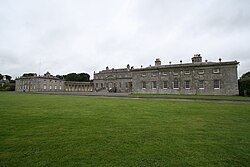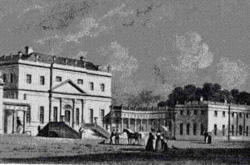Russborough House: Difference between revisions
Created page with "{{Infobox house |name=Russborough House |county=Wicklow |picture=Russborough house.jpg |picture caption=Russborough House |os grid ref=N95761106 |latitude=53.141687 |longitude..." |
|||
| Line 61: | Line 61: | ||
*[http://kildare.ie/heritage/historic-sites/russborough.asp Info from kildare.ie] | *[http://kildare.ie/heritage/historic-sites/russborough.asp Info from kildare.ie] | ||
*[http://www.rte.ie/news/2001/0626/paintings2.html RTE: History of robberies in Russborough] | *[http://www.rte.ie/news/2001/0626/paintings2.html RTE: History of robberies in Russborough] | ||
* | *Dolnick, Edward: 'The Rescue Artist' (HarperCollins, 2005) ISBN 978-0-06-053117-1 | ||
[[Category:Art galleries in County Wicklow]] | [[Category:Art galleries in County Wicklow]] | ||
Latest revision as of 22:41, 17 January 2019
| Russborough House | |
| County Wicklow | |
|---|---|
 Russborough House | |
| Location | |
| Grid reference: | N95761106 |
| Location: | 53°8’30"N, 6°34’10"W |
| History | |
| Built 1741 and 1755 | |
| For: | Joseph Leeson, 1st Earl of Milltown by Richard Cassels |
| Country house | |
| Palladian | |
| Information | |
Russborough House is a stately house near the Blessington Lakes in County Wicklow, between the towns of Blessington and Ballymore Eustace, and it is reputed to be the longest house in Ireland, with a frontage measuring 700 feet.
The house is a fine example of Palladian architecture, designed by Richard Cassels for Joseph Leeson, 1st Earl of Milltown and built between 1741 and 1755. The interior of the house contains some ornate plasterwork on the ceilings by the Lafranchini brothers, who also collaborated with Cassels on Carton House.
History

The Leeson family originated in Northamptonshire but had moved to Ireland in the second half of the 17th century. A sizeable fortune made in brewing and property development in Dublin passed down to Joseph Leeson, who bought land at what was then Russelltown. He became a Member of Parliament and was made Earl of Milltown in 1763.
Russborough House was designed for Joseph Leeson by Richard Cassels and built between 1741 and 1755. It remained in the possession of the Earls of Milltown until the Sixth Earl. On the death of his widow in 1914, it passed to a nephew, Edmund Turton, who rarely stayed there. On Turton's death in 1929, his widow sold the house to Captain Denis Bowes Daly in 1931.
Sir Alfred and Lady Beit bought Russborough in 1952 from Captain Daly to house their art collection and in 1976 established the Alfred Beit Foundation to manage the property. The foundation opened the historic mansion and its collections to the Irish public in 1978. Beit died in 1994 but Lady Beit remained in residence until her own death in 2005.
On 7 February 2010, a fire severely damaged the west wing and caused part of the roof to collapse. No art was damaged, being removed along with furniture to allow for restorations to the west wing. Initial examinations of the damage suggested an electrical fault from wiring in the roof may have sparked the fire.[1]
In recent years locally advertised Farmers Markets have been held on a regular basis in the grounds of the house.
Art collections
Russborough has housed two fine art collections, begun with the Milltown estate, whose collection was donated to the National Gallery of Ireland by the widow of the sixth earl.
Sir Alfred Beit bought the house in 1952, and here he housed his own family's collection, comprising works by many great artists, including Goya, Vermeer, Peter Paul Rubens and Thomas Gainsborough. This collection was since stolen four times:
- In 1974 by an IRA gang including British heiress Rose Dugdale;[2]
- In 1986 by Martin Cahill (nicknamed "The General");
- In 2001, and in 2002 by Martin Cahill's associate Martin Foley.
Two paintings, Gainsborough's Madame Bacelli and Vermeer's Lady writing a Letter with her Maid, the latter probably the most valuable painting of the collection, were stolen twice across the thefts, although each was subsequently recovered (the latter in 1993, the same year as the recovery of Goya's 'Portrait of Dona Antonia Zarate[3]).
The Beit Collection has donated many of its works to the state but substantial proportion of the paintings have been returned and been made available to view by the owners, the Alfred Beit Foundation. Other paintings which have returned are four Claude Joseph Vernet paintings entitled 'Morning', 'Midday', 'Sunset', and 'Night'- these were actually painted for Russborough in the 1750s and had remained in the house for most of the last 260 years.
In film and popular culture
Russborough House has been used as a dramatic setting or filming location on a number of occasions, including:
- Haywire (2011 film)
- Love & Friendship (2016 film)[4]
- On an episode of Travel Channel's Mysteries at the Castle, re-telling the story of the 1974 art heist.
- Black47, a 2018 film relating to the Great Irish Famine
Outside links
References
- ↑ Russborough House damaged in fire, The Irish Times, 8 February 2010
- ↑ "No regrets for renegade IRA art robber Rose Dugdale". Irish Independent. http://www.independent.ie/lifestyle/no-regrets-for-renegade-ira-art-robber-rose-dugdale-30238446.html.
- ↑ Dolnick, Edward. "How Ireland got back its Vermeer". The Times, 31 July 2005. Retrieved on 24 May 2009.
- ↑ McGrath, Meadhbh (27 May 2016). "'I loved the locations, they were perfect for us' - director Whit Stillman talks filming Love & Friendship in Ireland". Irish Independent. http://www.independent.ie/entertainment/movies/i-loved-the-locations-they-were-perfect-for-us-director-whit-stillman-talks-filming-love-friendship-in-ireland-34749072.html. Retrieved 15 July 2016.
- Info from kildare.ie
- RTE: History of robberies in Russborough
- Dolnick, Edward: 'The Rescue Artist' (HarperCollins, 2005) ISBN 978-0-06-053117-1